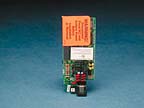
1. Network Connectivity
Now that more and more homes and businesses have Ethernet local area networks and broadband Internet connections, it’s a logical move for alarm systems to piggyback onto that investment for communication with central stations, guard booths – and directly to end users.“When it comes to communication, digital dialers have been No. 1, radio backup is No. 2 and the Internet is barely out there – but at some point, that pattern will be inverted,†predicts Wells Sampson, vice president of American Alarm and Communications Inc., an Arlington, Mass.-based alarm dealer.
A key advantage of using network connectivity is that it saves on the cost of the phone call that would otherwise be entailed in using a digital communicator – although installers typically will still connect the communicator to serve as a backup if the network connection should fail. Because of the reduced communication costs, systems also may send more information to the central station now.
“The central station can have a complete data record without having to interrogate the control,†says David Heinen, product marketing manager for enterprise systems for Bosch Security Systems, Fairport, N.Y. By using Internet connectivity, dealers also can let end users check the status of their systems through a browser interface from any computer – or even from some cell phones.
Although network connectivity typically has been achieved through a separate module attached to the alarm panel, at least one manufacturer – DMP of Springfield, Mo. – has begun to build connectivity directly into the panel. The built-in version costs about half as much as the previous-generation solution that required a separate module, DMP claims. Bosch, meanwhile, has reduced the size and cost of its network interface module that enables its central station receiver to communicate with control panels from a variety of manufacturers.
As an alternative to broadband or LAN connectivity, GE Security’s Simon system can use an inexpensive two-way paging network to send information to a network operations center (NOC). Authorized end users can access information stored at the NOC through a browser interface, which they can use to arm and disarm the system and perform other functions. End users also can receive notification if, for example, the power goes off in their home – a benefit that might be viewed as too pricey if handled through a central station.
“New paths for getting information to the end user is a big trend,†says Duane Paulson, vice president of global residential marketing for GE Security, Arden Hills, Minn.
2. A New Approach to Line Security
Network connectivity has paved the way for a more economical way of ensuring line security for the highest security installations. Bosch, for example, has a module that can send what the company calls a “heartbeat†to the central station every 75 seconds to verify that the system is operational. Theoretically, the same approach could have been used with digital dialer communication, but the cost of repeated transmissions to the central station would have been prohibitively expensive. The new approach is also less expensive than dedicated lines, which until now have been the primary method for providing line security.
3. Video and Audio Alarm Verification
Now that some municipalities have refused to dispatch police unless an alarm has been verified, the industry has made it a high priority to find practical verification methods. Two methods aimed at achieving that are video and audio verification. With video verification, an alarm signal triggers a surveillance camera to send an image from the site of the alarm to the central station. With audio verification, two-way voice communication is established through microphones located at the site and at the central station.A number of issues remain to be resolved with both of these options, however. Some dealers question the quality of video images sent to the central station, particularly when a low-speed dial-up line is used for communication. With two-way audio, a big concern is that the central station may not be able to record the goings-on because that may be in violation of wire tapping laws.
American Alarm’s Sampson, feels that video verification could begin to surge as more and more customers begin to have broadband connections, adding that one of his commercial customers was able to save on guard costs by adding remote video capability.

4. CP-01 Compliance
After a standards and development process that spanned several years, alarm panels conforming to the Security Industry Association’s CP-01 standard have begun to appear on the market. The standard specifies a range of features aimed at reducing false alarms, such as swinger shut-down (which bypasses zones that alarm repeatedly due to an intermittent sensor) or cross-zoning (which signals an alarm only if two closely located sensors are tripped). Although he doesn’t use every capability defined by the CP-01 standard, Sampson says, “It’s commendable that there’s been such an effort.â€
5. Integrated Access Control or Home Automation
Alarm panels now are being called upon to provide more than just intrusion protection. Increasingly they are providing the smarts to control other types of systems, such as access control or home automation systems, including audio and energy management systems. By integrating GE Security's alarm and audio systems, for example, a user could set up the combined system to announce “You’ve got mail†on audio devices throughout the house when the postman opens the box to make his daily delivery.Access control also is beginning to move into the residential market. GE’s NetworX control panel, for example, now has a door controller built in, enabling cleaning or repair people to gain access without having to remember a code – and reducing the likelihood of false alarms when personnel cannot remember their codes.
Lower costs and tighter levels of integration are another trend. DMP, for example, expects to introduce a lower-cost version of its keypad with built-in proximity reader later this year.

6. Easier-to-Use Keypads
As alarm control systems become more powerful, it’s become more critical to offer customers an intuitive way to control those systems. Bosch has introduced what it calls an ATM-style keypad that has built-in help screens and eight soft keys. The function of the soft keys changes as the keypad’s display screen changes, depending on how the customer is using it.Honeywell has taken a similar approach with its full-color graphic display keypad. “It’s a much better way to sell a product and take the complexity out of advanced features like scheduling and energy management,†says Gordon Hope, vice president of marketing for Honeywell. Hope adds that Honeywell expects to launch a less expensive black-and-white version by the middle of this year.
Keypad appearance continues to be a concern. DMP has introduced a keypad model that looks like a sheet of glass when not in use; it awakens to display a user interface when touched.

7. Bigger Systems
Another trend is towards panels that can control larger-than-ever systems. DMP, for example, recently introduced the XR500 system that can support 500 zones, 10,000 users, and 16 access control doors and can retain 12,000 events in its memory.
Bosch’s Heinen also sees a trend towards larger systems. Bosch is developing a new model 9512 for release next year that will have twice as many zones as the company’s current high-end model, the 9412. The new model will support more users, more relay outputs and more access control doors.

8. Built-in Light Sensors
Hoping to discourage muggers, several states have passed laws enabling them to issue fines if the lights outside a bank’s automatic teller machine are not functioning properly – and banks are turning to their alarm companies for help in complying with these new laws. DMP is one manufacturer that offers a solution here. The company has built adjustable light sensors into some of its panels that send a message to the central station if the light goes below a certain level. The central station can then either alert someone at the bank or call the police, depending on how it has been instructed by the client.Sidebar
What Dealers Wish Panels Could Do
What features would alarm dealers like to see in their control panels that they don’t have today?“I’d like to see better diagnostics,†says Rick Simpson, vice president of technical services for Vector Security in its Plymouth Meeting, Mass., branch. Today’s automobiles provide warnings about parts that are ready to fail so that the parts can be replaced before a real problem occurs. Why can’t alarm panels do the same? asks Simpson.
Simpson also would like to see more consistency from one manufacturer to the next – in everything from programming to central station reporting to keypad operation.
It seems security dealers are thinking alike when it comes to an automated method of arming and disarming a security system that would eliminate a high percentage of false alarms.
“I’d like to see voice recognition be a standard in the alarm so that clients could operate their system by just speaking to it,†says Joe Ingegno, senior vice president/owner, World Wide Security/GC Alarm, Garden City, N.Y. “I’d also like to see an application where a customer could have either some sort of card reader or watch that has a chip in it, which when they sweep it by a reader it will arm and disarm the system. One of the false alarm problems that we find is that customers will arm the system, leave their house, run back in within 30 seconds and run back out, and because it’s now on the entry time, they don’t hear the alarm ringing and it creates a false alarm.â€
Additionally, security dealers would like to have more powerful integration built into alarm panels.
“I’d like to see one complete low-voltage package with more and more integration, especially video,†says Wells Sampson, vice president of American Alarm and Communications in Arlington, Mass. Such a system, he says, would be lower cost and would be easier to sell and install.
And tomorrow’s alarm panel may be detecting more than intrusions and smoke. “Any high-quality alarm panel basically is a module that can report any kind of electronic condition, so if you were able to tie a monitor that can sniff the air you could have it detect high pollen counts, high ozone layers, and of course, once the price of technology comes down, you can have it detect any kind of biological or chemical agent in the air,†Ingegno says.




